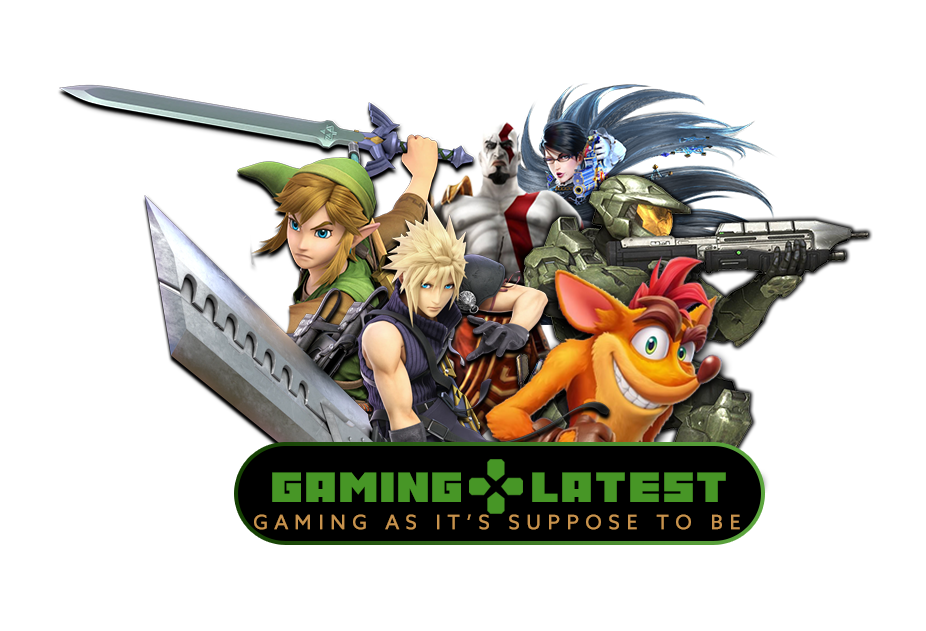Read on Smash Bros' creator interview from the guardian:
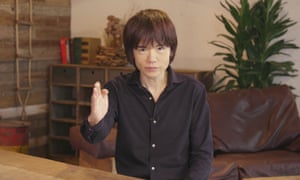
‘No one sets out to create a game that isn’t fun’ … Super Smash Bros Ultimate director Masahiro Sakurai speaks during Nintendo’s E3 Direct broadcast
Masahiro Sakurai is 48 years old, but looks almost ageless. In his face, you can see the prodigious teenager he once was. Sakurai was 19 when he directed his first game, Kirby’s Dream Land, at HAL Laboratory, a Tokyo developer that made a string of excellent games for Nintendo’s consoles in the 90s. His parents were perplexed; in their generation, video games didn’t exist. “They never supported me actively, there was a lot of uncertainty and fear,” he recalls. “That said, after I worked on the Kirby games, I noticed that all of a sudden my parents had Kirby paraphernalia hanging around the house.”
At his own company, Sora Ltd, Sakurai is now the director and public face of Smash Bros, Nintendo’s chaotic fighting game that features characters from throughout its 35-plus-year history alongside special guests from elsewhere in the gaming world, such as Final Fantasy’s Cloud, Sonic and Metal Gear Solid’s Snake. He is a calm presence in Nintendo Direct broadcasts, which deliver a drip-feed of information to fans, going into almost comically deep detail on characters’ moves and animations and occasionally betraying a deadpan sense of humour.
The next iteration, Smash Bros Ultimate, will be released for the Nintendo Switch in December, and attempts the daunting task of bringing together all of the 60-plus characters that have ever appeared in the series: an idea that Sakurai says was met with dead silence when he announced it to the development team.
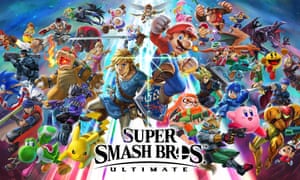
All for one … the artwork for Super Smash Bros Ultimate, coming soon for Nintendo Switch.
You will rarely meet a more enthusiastic student of video games than Sakurai. Developers, especially if they have been making games a long time, often end up with tunnel vision, playing little outside their own sphere. But Sakurai plays everything. He writes an entertaining column for Japan’s weekly gaming magazine Famitsu. His Tokyo home is stuffed with video games from all eras: “I have so many that I can’t even think about displaying them,” he says with a laugh. “Nowadays I try to go for download versions, to not take up as much space … one of the biggest challenges of living in Tokyo is not having space to do anything.”
Sakurai’s interest in games began, as it does for most of us, in childhood, but it really took hold while he was studying industrial design at school. “I was striving to become an engineer, but something happened that made me think, maybe I can make games instead,” he says. “There was a two-year-period in school where I would do a part-time job to make enough money to buy games, that I would play to research.
“I went out of my way to play games I didn’t like or find interesting. Those ended up being a lot more informative for me. At home I have literally thousands of games, and I think of them as pearls of wisdom from my predecessors. Game development is very difficult. Nobody sets out to create a game that’s not fun. It’s all of the challenges and difficulties that happen throughout development that determine whether a game is a failure or a success. I think playing those thousands of games is the single best and easiest way to learn from my predecessors.”

‘This is a game that lends itself to creating community’ … Sakurai at a Super Smash Bros invitational tournament at the E3 conference in LA. Photograph: Getty Images
This endearingly nerdy approach makes Sakurai ideal for Smash Bros. “I feel like it should be a dream project for anybody who is into video games!” he says. “The fact that we can collaborate with all these different people and characters and meld that all together without any inconsistencies is something I am very proud of.” The Smash games are stuffed with references to Nintendo and other video game history, from the obvious (Mario, Zelda and Pokémon) to the obscure (Earthbound, Brain Age, Starfy). The main characters are usually drawn from popular games, but items, trophies, costumes and stages allow for hundreds of cameos. This is part of what makes Smash so brilliant for Nintendo fans: even if you’re not the best at beating up your friends, you get a kick out of spotting something you recognise.
I had always presumed there would be a team of researchers mining Nintendo history for possible items and assist-trophy cameos but in fact Sakurai comes up with a lot of them himself, working from a huge list of ideas that gets narrowed down to cameos and items that aren’t too samey. “In gaming in general, a lot of characters fight with swords,” he says gloomily.
The Smash Bros series has to walk a difficult line between satisfying the kind of player who wants to have fun with their friends and enjoy some Nintendo fan-service, and satisfying a thriving competitive scene in which professional players play for glory and prize money. You can see it in the Smash Bros Nintendo Direct broadcasts: a lot of time is spent on the specifics of animation frames, ledge-cancelling and other details that only the most dedicated players would notice. Sakurai often watches pro Smash tournaments online. “The one thing I always think is that, if only they used more different stages and items, there’d be a lot more variety in the gameplay,” he says.
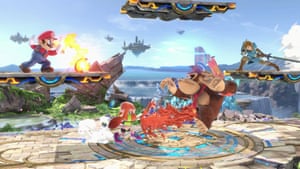
Mario and Donkey Kong, among others, in a screenshot of Super Smash Bros Ultimate.
“If we were to lean towards one kind of player or the other … game development would be easier, but forgoing the pros, or forgoing the beginners, wouldn’t result in Smash as it is now, and that’s something I hold dear and important,” he says.
“In the arcades, when I was younger, there was a game called King of Fighters 95, and I thought I was pretty good. I had a 50-strong win streak on Street Fighter 2 around that time. So I was playing King of Fighters once – and the way arcades are set up in Japan, you can’t really see the person you’re playing against, because you’re on opposite sides of the cabinet. I was feeling pleased with myself because I was winning, and it turned out to be a total beginner with their partner, just trying to have fun, and I thought, ‘Oh no, I shouldn’t have beaten them so badly. Now they’re going to feel like they never want to play it again!’ It’s important to think about the beginner crowd.”
There aren’t many games with a wider appeal than Smash. As well as staking out territory in the fighting game community, it is enjoyable for anyone who has ever played a Nintendo game, which, especially in North America and Japan, is almost everyone. As a kid, I played Smash Bros on the N64 with my brother, taking great delight in beating up his Yoshi. As a college student in Japan, I played Smash Bros Melee with my dorm-mates as a form of quasi-communication before my Japanese was good enough for real conversation. Now I look forward to playing it with my son someday – and indulging in some Nintendo nostalgia with my friends when Smash Bros Ultimate comes out on Nintendo Switch later this year.
“I realise that this is a game that lends itself to creating community,” says Sakurai. “That’s something I’ve been aware of since the initial iteration on N64. I really want to continue to create something that doesn’t break or shatter that.”
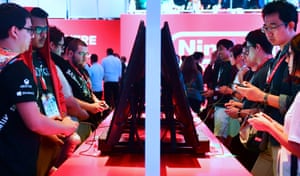
Gamers play Super Smash Bros on the Nintendo Switch at E3 in Los Angeles in June 2018. Photograph: Frederic J Brown/AFP/Getty Images
Sakurai is a notorious workaholic. His Famitsu columns documented seven-day work weeks in the run-up to the release of the last Smash Bros game, and in 2013 he developed tendinitis in his shoulder. He has since reduced his excessive hours, but he seems to enjoy making games so much – and Smash Bros in particular – that you’d think he’d want to stay involved in game development until he retires. He surprises me by saying otherwise. “I actually don’t feel that way at all! The best way to enjoy video games is to play what other people have made. But at the same time, I have a role. At this point I have been asked to create Smash and so I am doing that, and will continue to do so if the demand is there.
“On the one hand, I play games because of my job, but on the other hand, games have this eternal, immortal attraction. Of course I do go back to old games if I need a refresher, but I think it is important to intentionally play and observe new games, to know what’s out there. Games that are coming out now are just incredible; they’re amazing. Even for people who say that they grow out of games, once they have kids and there’s a game they can play together, they return. It’s not about quitting or graduating from playing games; it’s about finding what’s enjoyable for you at that time in your life, and playing that.”

‘No one sets out to create a game that isn’t fun’ … Super Smash Bros Ultimate director Masahiro Sakurai speaks during Nintendo’s E3 Direct broadcast
Masahiro Sakurai is 48 years old, but looks almost ageless. In his face, you can see the prodigious teenager he once was. Sakurai was 19 when he directed his first game, Kirby’s Dream Land, at HAL Laboratory, a Tokyo developer that made a string of excellent games for Nintendo’s consoles in the 90s. His parents were perplexed; in their generation, video games didn’t exist. “They never supported me actively, there was a lot of uncertainty and fear,” he recalls. “That said, after I worked on the Kirby games, I noticed that all of a sudden my parents had Kirby paraphernalia hanging around the house.”
At his own company, Sora Ltd, Sakurai is now the director and public face of Smash Bros, Nintendo’s chaotic fighting game that features characters from throughout its 35-plus-year history alongside special guests from elsewhere in the gaming world, such as Final Fantasy’s Cloud, Sonic and Metal Gear Solid’s Snake. He is a calm presence in Nintendo Direct broadcasts, which deliver a drip-feed of information to fans, going into almost comically deep detail on characters’ moves and animations and occasionally betraying a deadpan sense of humour.
The next iteration, Smash Bros Ultimate, will be released for the Nintendo Switch in December, and attempts the daunting task of bringing together all of the 60-plus characters that have ever appeared in the series: an idea that Sakurai says was met with dead silence when he announced it to the development team.

All for one … the artwork for Super Smash Bros Ultimate, coming soon for Nintendo Switch.
You will rarely meet a more enthusiastic student of video games than Sakurai. Developers, especially if they have been making games a long time, often end up with tunnel vision, playing little outside their own sphere. But Sakurai plays everything. He writes an entertaining column for Japan’s weekly gaming magazine Famitsu. His Tokyo home is stuffed with video games from all eras: “I have so many that I can’t even think about displaying them,” he says with a laugh. “Nowadays I try to go for download versions, to not take up as much space … one of the biggest challenges of living in Tokyo is not having space to do anything.”
Sakurai’s interest in games began, as it does for most of us, in childhood, but it really took hold while he was studying industrial design at school. “I was striving to become an engineer, but something happened that made me think, maybe I can make games instead,” he says. “There was a two-year-period in school where I would do a part-time job to make enough money to buy games, that I would play to research.
“I went out of my way to play games I didn’t like or find interesting. Those ended up being a lot more informative for me. At home I have literally thousands of games, and I think of them as pearls of wisdom from my predecessors. Game development is very difficult. Nobody sets out to create a game that’s not fun. It’s all of the challenges and difficulties that happen throughout development that determine whether a game is a failure or a success. I think playing those thousands of games is the single best and easiest way to learn from my predecessors.”

‘This is a game that lends itself to creating community’ … Sakurai at a Super Smash Bros invitational tournament at the E3 conference in LA. Photograph: Getty Images
This endearingly nerdy approach makes Sakurai ideal for Smash Bros. “I feel like it should be a dream project for anybody who is into video games!” he says. “The fact that we can collaborate with all these different people and characters and meld that all together without any inconsistencies is something I am very proud of.” The Smash games are stuffed with references to Nintendo and other video game history, from the obvious (Mario, Zelda and Pokémon) to the obscure (Earthbound, Brain Age, Starfy). The main characters are usually drawn from popular games, but items, trophies, costumes and stages allow for hundreds of cameos. This is part of what makes Smash so brilliant for Nintendo fans: even if you’re not the best at beating up your friends, you get a kick out of spotting something you recognise.
I had always presumed there would be a team of researchers mining Nintendo history for possible items and assist-trophy cameos but in fact Sakurai comes up with a lot of them himself, working from a huge list of ideas that gets narrowed down to cameos and items that aren’t too samey. “In gaming in general, a lot of characters fight with swords,” he says gloomily.
The Smash Bros series has to walk a difficult line between satisfying the kind of player who wants to have fun with their friends and enjoy some Nintendo fan-service, and satisfying a thriving competitive scene in which professional players play for glory and prize money. You can see it in the Smash Bros Nintendo Direct broadcasts: a lot of time is spent on the specifics of animation frames, ledge-cancelling and other details that only the most dedicated players would notice. Sakurai often watches pro Smash tournaments online. “The one thing I always think is that, if only they used more different stages and items, there’d be a lot more variety in the gameplay,” he says.

Mario and Donkey Kong, among others, in a screenshot of Super Smash Bros Ultimate.
“If we were to lean towards one kind of player or the other … game development would be easier, but forgoing the pros, or forgoing the beginners, wouldn’t result in Smash as it is now, and that’s something I hold dear and important,” he says.
“In the arcades, when I was younger, there was a game called King of Fighters 95, and I thought I was pretty good. I had a 50-strong win streak on Street Fighter 2 around that time. So I was playing King of Fighters once – and the way arcades are set up in Japan, you can’t really see the person you’re playing against, because you’re on opposite sides of the cabinet. I was feeling pleased with myself because I was winning, and it turned out to be a total beginner with their partner, just trying to have fun, and I thought, ‘Oh no, I shouldn’t have beaten them so badly. Now they’re going to feel like they never want to play it again!’ It’s important to think about the beginner crowd.”
There aren’t many games with a wider appeal than Smash. As well as staking out territory in the fighting game community, it is enjoyable for anyone who has ever played a Nintendo game, which, especially in North America and Japan, is almost everyone. As a kid, I played Smash Bros on the N64 with my brother, taking great delight in beating up his Yoshi. As a college student in Japan, I played Smash Bros Melee with my dorm-mates as a form of quasi-communication before my Japanese was good enough for real conversation. Now I look forward to playing it with my son someday – and indulging in some Nintendo nostalgia with my friends when Smash Bros Ultimate comes out on Nintendo Switch later this year.
“I realise that this is a game that lends itself to creating community,” says Sakurai. “That’s something I’ve been aware of since the initial iteration on N64. I really want to continue to create something that doesn’t break or shatter that.”

Gamers play Super Smash Bros on the Nintendo Switch at E3 in Los Angeles in June 2018. Photograph: Frederic J Brown/AFP/Getty Images
Sakurai is a notorious workaholic. His Famitsu columns documented seven-day work weeks in the run-up to the release of the last Smash Bros game, and in 2013 he developed tendinitis in his shoulder. He has since reduced his excessive hours, but he seems to enjoy making games so much – and Smash Bros in particular – that you’d think he’d want to stay involved in game development until he retires. He surprises me by saying otherwise. “I actually don’t feel that way at all! The best way to enjoy video games is to play what other people have made. But at the same time, I have a role. At this point I have been asked to create Smash and so I am doing that, and will continue to do so if the demand is there.
“On the one hand, I play games because of my job, but on the other hand, games have this eternal, immortal attraction. Of course I do go back to old games if I need a refresher, but I think it is important to intentionally play and observe new games, to know what’s out there. Games that are coming out now are just incredible; they’re amazing. Even for people who say that they grow out of games, once they have kids and there’s a game they can play together, they return. It’s not about quitting or graduating from playing games; it’s about finding what’s enjoyable for you at that time in your life, and playing that.”
